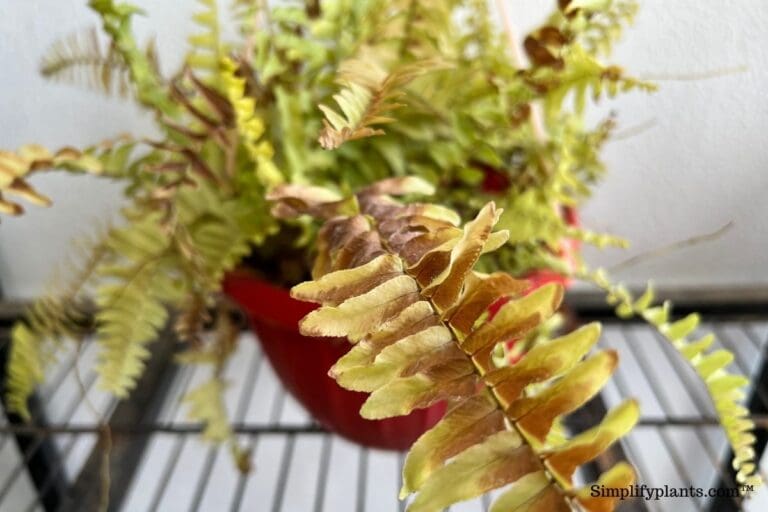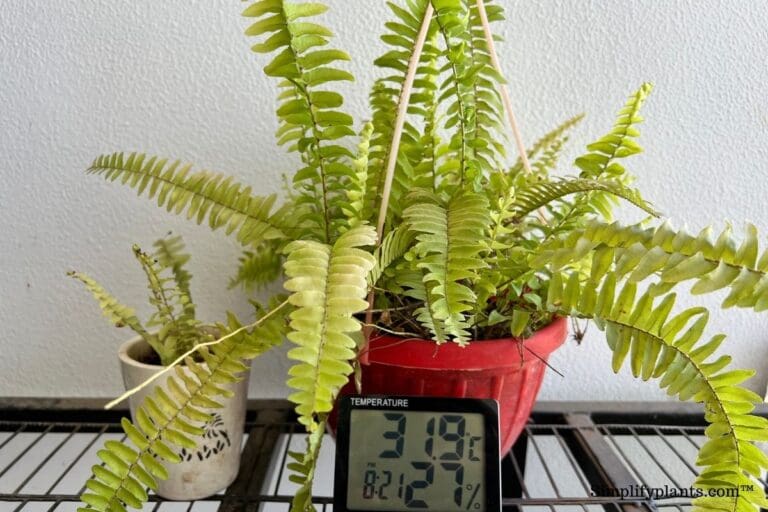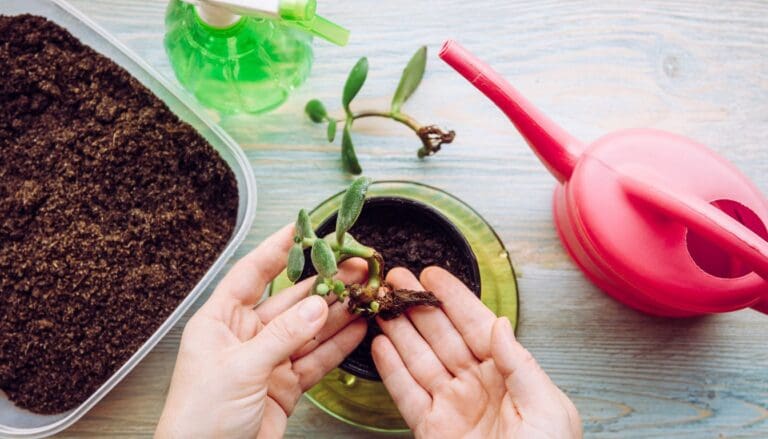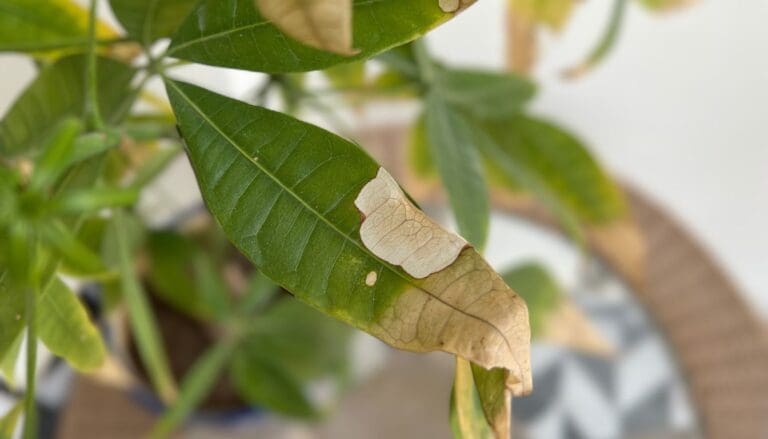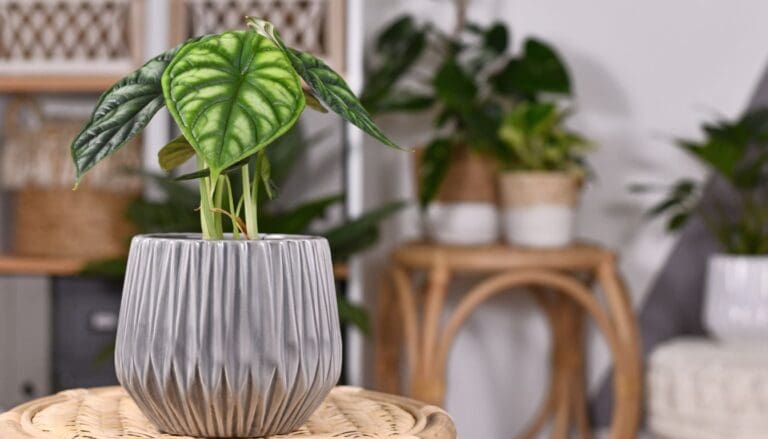How Often Do You Water A Monstera? (Watering Requirements+Tips)
Watering is crucial for Monsteras as it encourages good hydration while preventing overwatering or underwatering. Let’s understand Monstera’s watering needs.
Water Monsteras every 1-2 weeks, or when the top 1-2 inches of soil is 80% dry but remains moist underneath. Regularly check soil moisture and adjust the watering by considering factors like temperature, humidity, light levels, soil type, and pot size that influence watering.
Today, I’ll share my 12 years of gardening experience with Monsteras, focusing on their watering needs, including frequency, influencing factors, techniques, and troubleshooting for overwatering and underwatering.
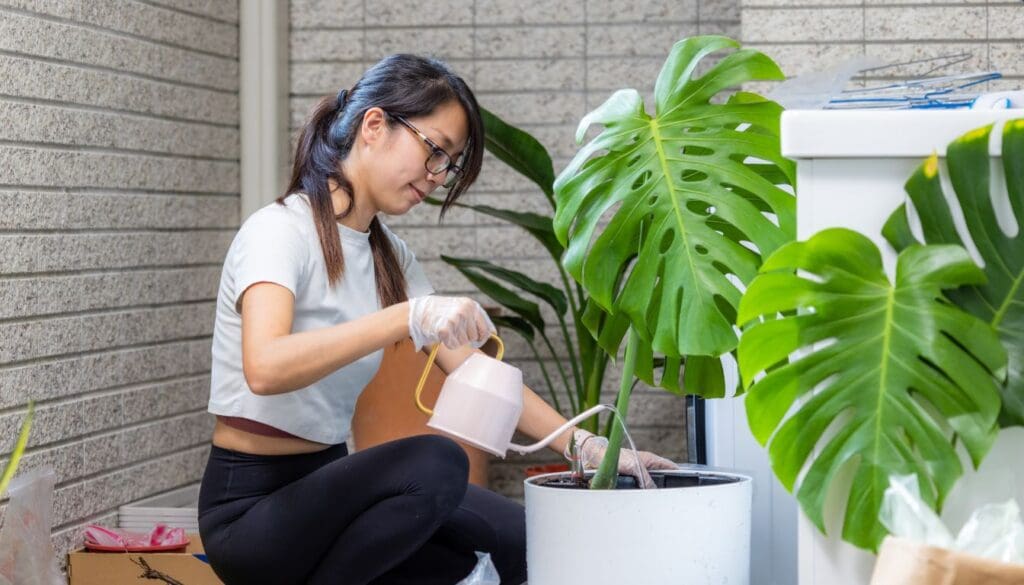
Please note: Simplify Plants is reader-supported. Some links in the post are affiliate links and I get a commission from purchases made through links in the post.
Basic watering fundamentals in Monstera
Watering Monsteras, or Swiss cheese plants, is a crucial weekly task.
Unfortunately, this is where most gardeners go wrong and stress their plants.
These epiphytes love to grow in consistently moist soil.
You should also let the soil dry out before the next watering.
Generally, Monsteras should be watered whenever the top 1-2 inches of their soil is 80% dry and the soil remains moist below it.
Check the soil moisture before every watering session.
It will help you gather experience about Monstera’s watering needs, and you can make a watering routine while avoiding water-related issues.
How often do you water Monsteras?
As I said, water Monsteras when the top few inches have dried.
Usually, the soil’s top few inches generally dries within a week or two.
Hence, you can water your Monsteras once every 1-2 weeks.
It depends because several factors can affect the frequency.
For example, when you water thoroughly, maintain high humidity, and reduce the light levels, Monsteras will stay without water for 2-3 weeks.
I will discuss the factors soon. Keep reading.
Best time of the day to water Monsteras

It is a long-debated topic among every Monstera grower.
I get several DMs where readers ask me my timing of watering my Monsteras.
Usually, I water my Monsteras in the early morning when the weather is still cool and the sun’s intensity is gentle.
The soil will stay moist, and your Monsteras will get enough time for the moisture to run through and get collected.
Water retention is better in the early morning before the sun’s heat increases, especially between 5:00 am and 9:00 am.
How much water do Monsteras need?
Generally, Monsteras will need 2 inches of water weekly while growing in pots.
I won’t recommend a fixed amount; it depends on your plant’s size and maturity—sometimes less, sometimes more.
To provide enough water, keep watering the plant until you notice the excess draining out the potholes.
5 factors affecting the watering frequency of Monstera plants
As I mentioned earlier, many factors can affect the watering frequency of the Monstera plants.
I water my Monsteras every 1-2 weeks, but sometimes, I increase or reduce the frequency.
I follow this routine if everything is perfect: light levels, temperature, humidity, soil type, and pot.
But if there are any changes in these factors, I change the frequency accordingly to prevent watering issues.
Let’s go through the factors that affect the watering frequency of Monsteras:
1. Light levels affecting the watering frequency of Monsteras
The sunlight helps the Monstera soil to dry out.
Watering every 1-2 weeks is the right watering frequency estimate based on the optimal light conditions.
If your Monsteras get brighter sunlight, the soil dries faster and must be watered more often.
The soil will take time to dry out under low lights.
Hence, reduce the frequency.
Here’s how often I water my Monsteras based on changes in the light levels:
- Brighter sunlight: Watering once or twice per week.
- Low lights: Watering every 2-3 weeks.
Before watering, checking the moisture level is mandatory.
2. Seasonal watering in Monstera

Season is another essential factor affecting the watering frequency for Monsteras.
In summer, the light levels and temperatures are high, which makes the soil dry out faster.
On the other hand, light levels and temperature in winter are low, sometimes crossing 50°F, for which the soil takes time to dry.
It can differ based on which USDA zone you live in and what temperatures you get in these seasons.
Here’s what I follow for my Monsteras:
- I water my Monsteras every 10-15 days in spring and summer.
- In fall and winter, I water them every 15-20 days.
Before watering, I check the soil moisture.
Sometimes, I don’t follow this routine if the top few inches are still moist.
I wait 2-3 days more to water my Monsteras.
3. Temperature and humidity affect Monstera’s watering frequency
Monsteras enjoy temperatures between 60°F and 80°F.
Watering every 1-2 weeks at this temperature range is acceptable.
An increase in temperature for longer periods dries out the soil faster.
On the contrary, cold snaps keep the soil moist for a long time.
Besides the season, room temperatures fluctuate when you use HVACs.
Here’s my routine of watering during temperature changes:
- Temperatures above 90°F: Water once or twice per week
- Low temperatures below 55°F: Water every 2-3 weeks
Humidity also has an impact on watering.
With low humidity, moisture loss increases, and the soil dries quickly.
Here, you can increase the watering frequency or humidity.
To increase humidity, install humidifiers, use pebble trays, or group tropical plants with Monsteras.
However, the soil will stay wet for around 2-3 weeks with high humidity levels.
You can follow the same temperature routine and check the soil moisture before watering.
4. Soil type affecting the watering frequency of Monsteras
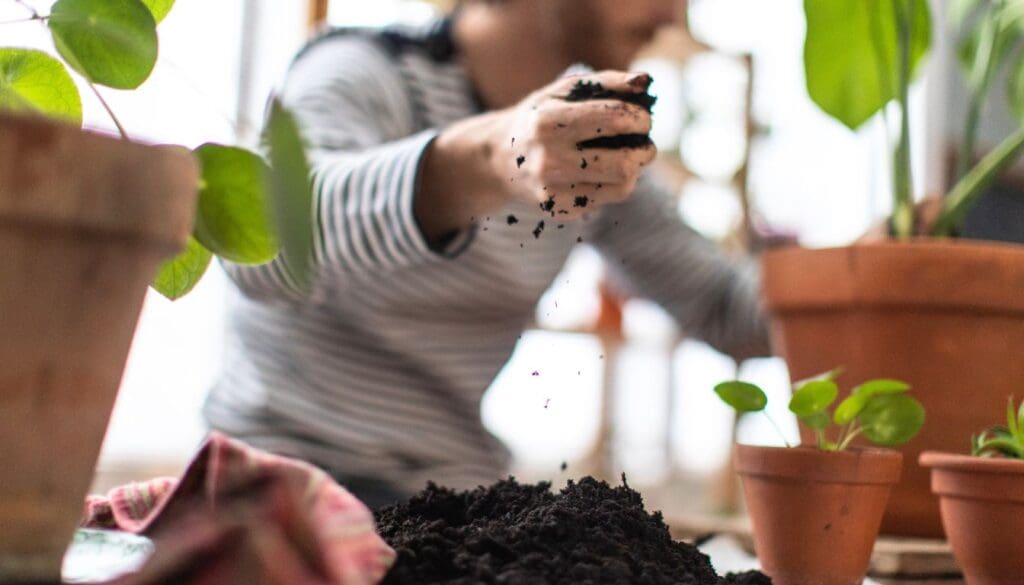
Monsteras enjoy soil that drains well while retaining the required moisture.
Heavy soil takes time to dry out, whereas fast-draining soil dries out quickly.
When the soil is dense, water Monsteras less often.
But with lighter potting soil, water more often for good hydration.
Follow the same routine as before:
- If the soil dries out, water every 15-20 days.
- If the soil dries faster, water every week or 2 times per week.
Checking and understanding the soil moisture before watering is recommended.
It is better to avoid dense soil mixes.
Even if you adjust the watering, the soil becomes compact, stays moist for too long, and inhibits root growth.
I use a combination of well-drained, all-purpose houseplant with ingredients like perlite or bark chips for good drainage and aeration.
5. Pot considerations for Monstera watering frequency
When it comes to pot, there are two things to check while watering Monsteras:
Monstera Pot size
Larger pots hold a lot of soil, and it takes time to dry out.
On the other hand, Monsteras in small pots dry out faster due to less soil.
Avoid too large or too small pots for Monsteras.
Monstera Pot material
Plastic pots can retain moisture, so the soil takes time to dry out.
In contrast, porous pots like unglazed ceramics, earthenware, or terracotta pots wick away moisture faster.
Follow the same watering routine for pot type and material as the other factors.
3 best ways to water Monstera

There are several techniques to water Monsteras.
You can use anyone of your choice since these plants are not very picky about the watering methods.
Here are three methods I would recommend:
1. Top watering in Monsteras
Top watering is one of the most convenient and easy methods of watering Monsteras.
Pour water directly into the soil with a watering can or a mug.
I prefer a watering can with a narrow mouth.
You can also put your Monstera under the tap and add water to the pot until the excess drains from the potholes.
Try not to splash water on the leaves.
If you have, clean it with a soft and dry cloth.
Wet leaves will, otherwise, invite pests and diseases.
Empty the saucer under the pot occasionally.
2. Monstera Bottom watering
I consider bottom watering when I underwater my Monsteras and the soil has hardened.
The method can saturate the soil very well and ensure good hydration.
Here’s what you should do:
- Take a tray and fill it with water.
- Put your Monstera pot over it, ensuring the soil touches the water on the container through the drainage holes.
- Let it stay for around 10 minutes, and then check the soil.
- Remove the pot and put it back in place if the soil is moist throughout.
- If it’s still not moist, keep it for another 10 minutes and recheck the soil.
- If you always water like this, remember that bottom watering will not remove the salts accumulated from the fertilizers. Consider top watering to flush the soil once a month.
3. Monstera Water bath
- Fill a deep container or bucket with lukewarm water.
- Put the Monstera pot in it and stop where the plant’s stem begins. Only the soil should be under water.
- Water will begin to bubble. Wait until the bubble stops, and then take out the pot.
- Drain the excess water and put the Monstera back in place.
- After an hour, check the tray or saucer and empty it. Do this occasionally.
2 common watering problems in Monstera
When watering Monsteras, incorrect watering can lead to two main issues: overwatering and underwatering.
Let’s understand why this happens and how to deal with them:
1. Overwatering Monstera and ways to deal with it

One of the most severe issues with Monsteras is overwatering.
As a beginner, when we try to provide adequate moisture, you don’t know how much or how frequently to provide it.
Hence, we end up overwatering.
Overwatering harms Monsteras by suffocating roots and inhibiting moisture and nutrient intake, photosynthesis, and chlorophyll production, causing stress.
Here are some overwatering signs in Monsteras:
- Yellow leaves
- Water dripping from the foliage ends
- New leaves with brown tips
- Wilted leaves
- Curly leaves
- Wet soil
- Foul smell and a soft and mushy plant base, indicating root rot
To fix overwatering in Monsteras, you need to identify the problem from the signs and then do the needful:
- Stop watering your Monsteras and let the soil dry out.
- Trim off the discolored leaves. It will help the plant focus on recovery and new growth instead of wasting the energy behind these leaves.
- Shift your plant to a brighter location with some sunlight. The warmth from the sun will aid in the drying of the soil.
If you suspect root rot, slide out the plant slightly and check the roots.
If you find any mushy roots with a foul smell, here’s what you can do to save the plant:
- Unpot your Monstera and remove the mushy and brown roots.
- Rinse the remaining roots with water and spray some fungicides or diluted hydrogen peroxide to kill the pathogens.
- Use a new pot and new soil mix to repot your Monstera.
- Care for your plant and avoid further stress.
- Once you notice new leaves, your Monstera will gradually recover with time and good care.
If maximum roots have decayed, find some good parts and propagate them.
2. Underwatering Monstera and ways to troubleshoot it

Another watering issue in the Monsteras is underwatering.
When underwatered, the roots remain dehydrated; hence, the plant struggles to absorb the moisture and nutrients, leading to dehydration.
Here are some signs of underwatering in Monsteras:
- Dry and crispy leaves due to the lack of water
- Leaves falling off
- Yellow and wilted leaves
- Yellow leaves are turning brown
- Dry soil
- The pot feels too light
To fix the issue, immediately start with deep and thorough watering.
Make holes with a fork or chopstick to let the water seep through it and reach the roots.
If the soil is too dry to repose the water, consider bottom watering or a water bath technique to water the dehydrated Monstera.
Remove the dry and discolored leaves to encourage new growth.
Preventing water-related issues and maintaining consistency for Monstera
The best way to prevent watering issues in Monstera is to check the soil moisture before watering.
Whenever the top 1-2 inches have dried, you can water it.
Here are 3 ways to understand when Monstera requires water:
- Poke your finger 1-2 inches deep in the soil; hold off watering for a few more days if the soil feels moist. If it’s dry but moist below 1-2 inches, water your Monstera.
- Don’t want your hands to get dirty? Use a wooden stick, like chopsticks or dowel into the soil. Hold your watering if the stick feels damp and dark soil sticks to it. If the stick comes out clean, water your plant.
- Use a moisture meter to check the moisture level accurately. Insert the sensor halfway between the plant base and the pot edge. A reading of 1-3 means dry, 4-7 means moist, and 8-10 means wet. Water the plant when it’s dry.
Finally, remember that consistency is the key.
Letting the soil dry out entirely and then suddenly pouring lots of water is not the right way to go.
The sudden application of water every time can shock the plant.
The best way to maintain a consistent moisture level is to check the soil moisture and keep notes of the dates you water.
It will help you understand when to water your Monstera and establish a routine.
Consistently moist soil promotes plant health and growth.
4 Monstera watering tips
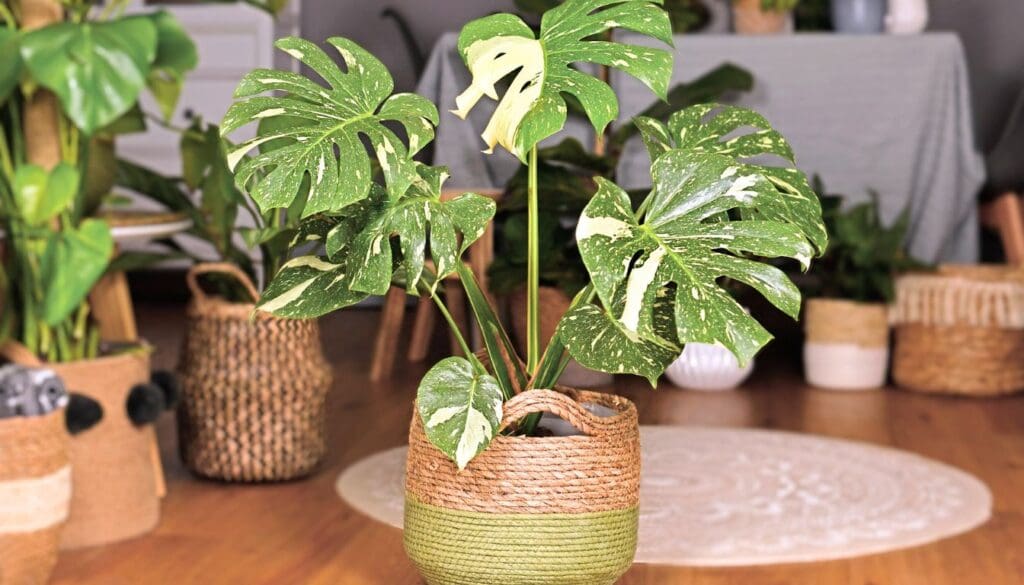
- Use room temperature water. Hot or cold water can shock Monsteras.
- Check the soil moisture level once a week to understand when Monsteras need water.
- Filtered or distilled water is the best option. You can use tap water, too, after letting it sit overnight so that the harsh minerals can evaporate.
- Underwatering Monsteras is better than overwatering. Adding water is easier than removing it.
Final thoughts
If you have welcomed a new Monstera in your house and are searching for the watering requirements, this guide can help you. Check the soil moisture once a week and water your Monsteras every 1-2 weeks or whenever the top few inches have dried.
Factors like light levels, temperature, humidity, soil type, seasons, and pot type can change the watering frequency. Adjust it accordingly. If you have overwatered, stop watering and let the soil dry. If there is a root rot, repot your Monstera. If you have underwatered, start watering.
Poke some holes to let the water seep and reach the roots, and consider bottom watering or a water bath if the soil has dried too much. Maintaining moisture consistency while watering the Monsteras keeps them healthy and hydrated and promotes good growth speed.
What type of water should I use for Monsteras?
Use filtered or distilled water for Monsteras. If using tap water, let it sit overnight to allow harsh minerals to evaporate.
How much water does a large Monstera need?
Regardless of the size, water your Monstera plant thoroughly when the top 1-2 inches of soil is dry. It should provide enough hydration for 1-2 weeks.
Reference: Monstera Wikipedia
Recommended Garden Supplies
| Product Image | Our Recommended Gardening Supplies | Check Offers! |
|---|---|---|
Top Top
Top
Top
Top
Top
Top
Top
Top | rePotme Houseplant and Tropical Classic Potting Soil Mix | Check Offer On Amazon |
 Top
Top
Top
Top
Top
Top
Top
Top | Espoma Organic Indoor Plant Food | Check Offer On Amazon |
 Top
Top
Top
Top
Top
Top
Top
Top | GooingTop LED Grow Light 6000K Full Spectrum Clip Plant Growing Lamp | Check Offer On Amazon |
 Top
Top
Top
Top
Top
Top
Top
Top | Soil Moisture Meter | Check Offer On Amazon |
 Top
Top
Top
Top
Top
Top
Top
Top | Govee Hygrometer Thermometer, Bluetooth Enabled! | Check Offer On Amazon |
 Top
Top | LEVOIT Humidifiers for Large Room(Best For Plants) | Check Offer On Amazon |
 Top
Top
Top
Top
Top
Top
Top
Top | Upgraded DIY Automatic Drip Irrigation Kit, 15 Potted Houseplants Support | Check Offer On Amazon |
 Top
Top
Top
Top
Top
Top
Top
Top | Stainless Steel Heavy Duty Gardening Tool Set | Check Offer On Amazon |
 Top
Top
Top
Top
Top
Top
Top
Top | Bonide Insecticidal Soap | Check Offer On Amazon |
 Top
Top
Top
Top
Top
Top
Top
Top | Bonide 32 oz Spray Neem Oil for Organic Gardening | Check Offer On Amazon |
 Top
Top
Top
Top
Top
Top
Top
Top | Garden Safe Fungicide | Check Offer On Amazon |

